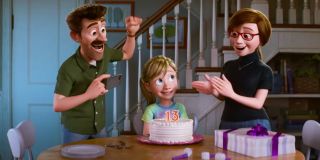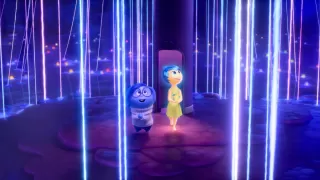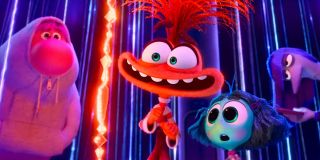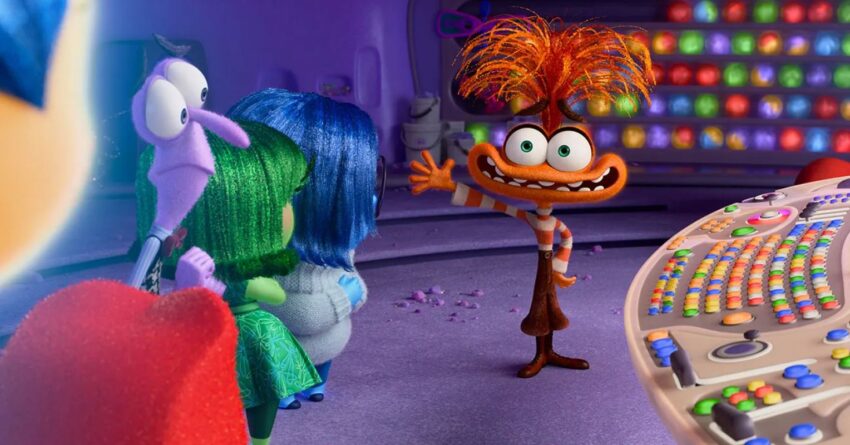Warning: Massive spoilers ahead.
Anyone who knows me will confirm that I am a child at heart. And, as a therapist, I obviously loved the first Inside Out movie. So when my daughter and wife took me to see Pixar’s Inside Out 2 for Father’s Day this year, I was excited to go. Little did I know that I was about to watch a movie that perfectly encapsulates the anxious experience and offers profound insights for those struggling with intrusive thoughts, shame, and anxiety.

Remember when you turned 13? Nothing weird happened then, right?
Source: ‘Inside Out 2’/Pixar
Briefly, Inside Out 2 continues the story of a just-turned-13-year-old girl named Riley who goes off to summer hockey camp with a couple of friends, puberty, and a whole host of new emotions. Her familiar emotions, including Joy, Sadness, Anger, Disgust, and Fear, are equally as unprepared as Riley is for the new crew. Headed by Anxiety, the emotions of Embarrassment, Envy, Ennui, and Nostalgia set out to help Riley navigate new social pressures and prepare for her future.
As Anxiety and company set to work tinkering with Riley’s personality, belief system, and tenuous interpersonal skills, we can see several familiar examples of how we experience big feelings, including anxiety, that offer us some ideas of how we can better understand our emotions, experience compassion for our struggles, and grow into stronger, more confident people.
Anxiety Is Just Looking out for Riley
For those of us with anxiety (i.e., everyone), we sometimes think anxiety is the enemy that does nothing for us. Nothing good, at least. However, Inside Out 2’s portrayal of Anxiety is of an emotion who, albeit erratic and haphazard, thinks she has Riley’s best interests at heart. Anxiety wants Riley to be aware of possible unwanted outcomes, consider how her choices could affect her future negatively, and hopefully guide her toward better opportunities and relationships.

Anxiety is a mixed bag of expectations.
Source: ‘Inside Out 2’/Pixar
At its core, this is true for us, too. Our anxiety is ultimately out for our best interest. But, just like Anxiety in the movie, our anxiety goes beyond gentle reminders. Instead, anxiety has a nasty habit of overwhelming us. It can be less of a guide and advisor and more like a dictator and fearmonger. But if we take a step back and think about anxiety as an imprecise warning signal that wants to help us move through life, then we can be less afraid and less controlled by anxiety.
Anxiety Co-opting Imagination to Produce Disastrous Scenarios
As the original group of emotions sets off to retrieve Riley’s discarded personality and thwart Anxiety’s scheme, they find the Imagination Department re-tasked with producing terrible scenarios about the following day, with Anxiety projecting those stories into Riley’s consciousness. Anxiety does this in an attempt to get Riley to act on a plan to give her an advantage during the next day’s hockey scrimmage.
This scene perfectly demonstrates how our anxiety, conspiring with our imagination, can drown us with intrusive thoughts that overwhelm us and sometimes convince us that we can expect only worst-case outcomes. Joy helps show us, as she did with Riley, that we can use our imagination for good by reminding ourselves that terrible outcomes are not the only option. We can have neutral, good, or even great outcomes, and we can be uncertain and unconvinced of any outcome until it happens.
Shame Developed With Anxiety’s Help
When the movie starts, we see Riley’s personality manifested in a beautiful swirl of symmetrical glowing threads rooted in her belief system. When touched, her personality resonates with the message “I’m a good person.”

Riley’s personality is produced by combining a number of her core beliefs.
Source: ‘Inside Out 2’/Pixar
However, throughout the movie, we see Anxiety’s deluge of intrusive thoughts questioning her character, intentions, skills, and future slowly shift this message to the gut-wrenching “I’m not good enough.”
When our anxious thoughts seem to fill with self-doubt, negative evaluation, and nit-picking every choice and act, we may come to the conclusion that we aren’t good enough. Unchallenged, our core belief can take the form of Shame. When this happens, it is vital that we take stock of the entirety of who we are, not just the worst parts, and offer ourselves kindness and self-compassion.
Riley’s Penalty Box Panic Attack
In the climax of the movie, Anxiety takes control of Riley’s board in a frantic effort to dominate the hockey game and impress her new coach. Anxiety’s worst-case scenario mental image tactic is in overdrive to the point where Anxiety becomes frozen by her own frenzied attempt to control the outcome of the game.

Here, we see Anxiety implanting a new core belief that will eventually grow into a personality built from anxiety and doubt.
Source: ‘Inside Out 2’/Pixar
Anxiety, in excess and without acceptance, can produce panic. This is anxiety beyond helpful levels accompanied by all the physical manifestations of the fight-flight-freeze system.
In a very tender moment, Joy saves the day by gently reminding Anxiety to let go of the controls and release Riley. This should be a gentle reminder to us that there are many things out of our control, and our attempts to re-double our efforts when we are hitting a brick wall most often result in heightened distress. Instead, we should let go, take a breath in the moment, and ground ourselves in the peace of reality, not in feared imagination.
Riley’s New Personality of All Emotions
At the end of the film, we see Riley’s personality embodied as a shifting, asymmetrical, smooth, gentle, yet jagged work of art. During the Battle of the Penalty Box, all the emotions put aside their allegiances to rally around Riley’s personality to protect it from the swirling chaos of the panic attack. As a result, the aforementioned beautiful glowing personality was replaced with one that, at first glance, is less impressive but ultimately exactly what Riley needed: a unified, accepted self.
Shame divides us emotionally. We are trapped in a fight for our goodness against the reality of our mistakes, failures, misguided actions, or simple human spite, just to name a few. We reject feelings and thoughts we perceive as “bad” in an effort to preserve “good.” Just like Riley’s emotions, we should work to instead accept ourselves as whole yet complicated people who are still good, acceptable, and worthy despite those times when we make mistakes and act out of character.
